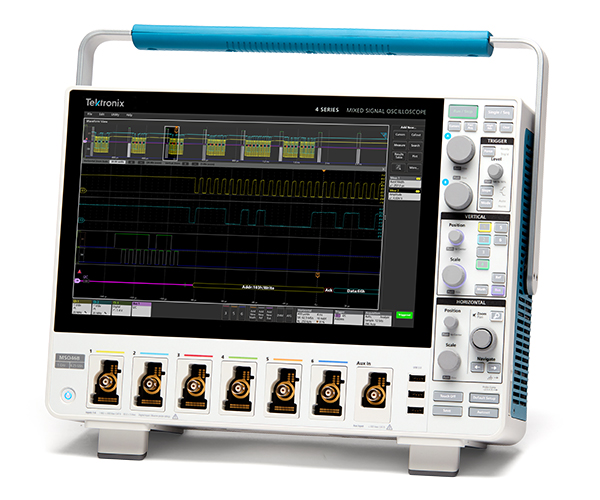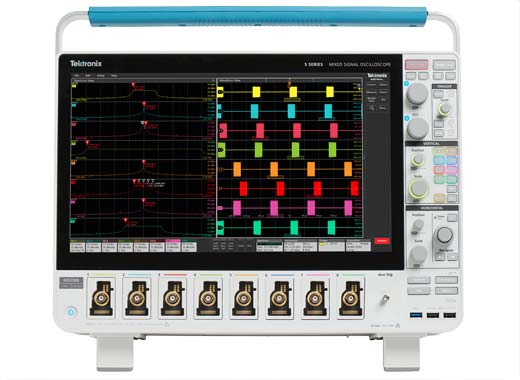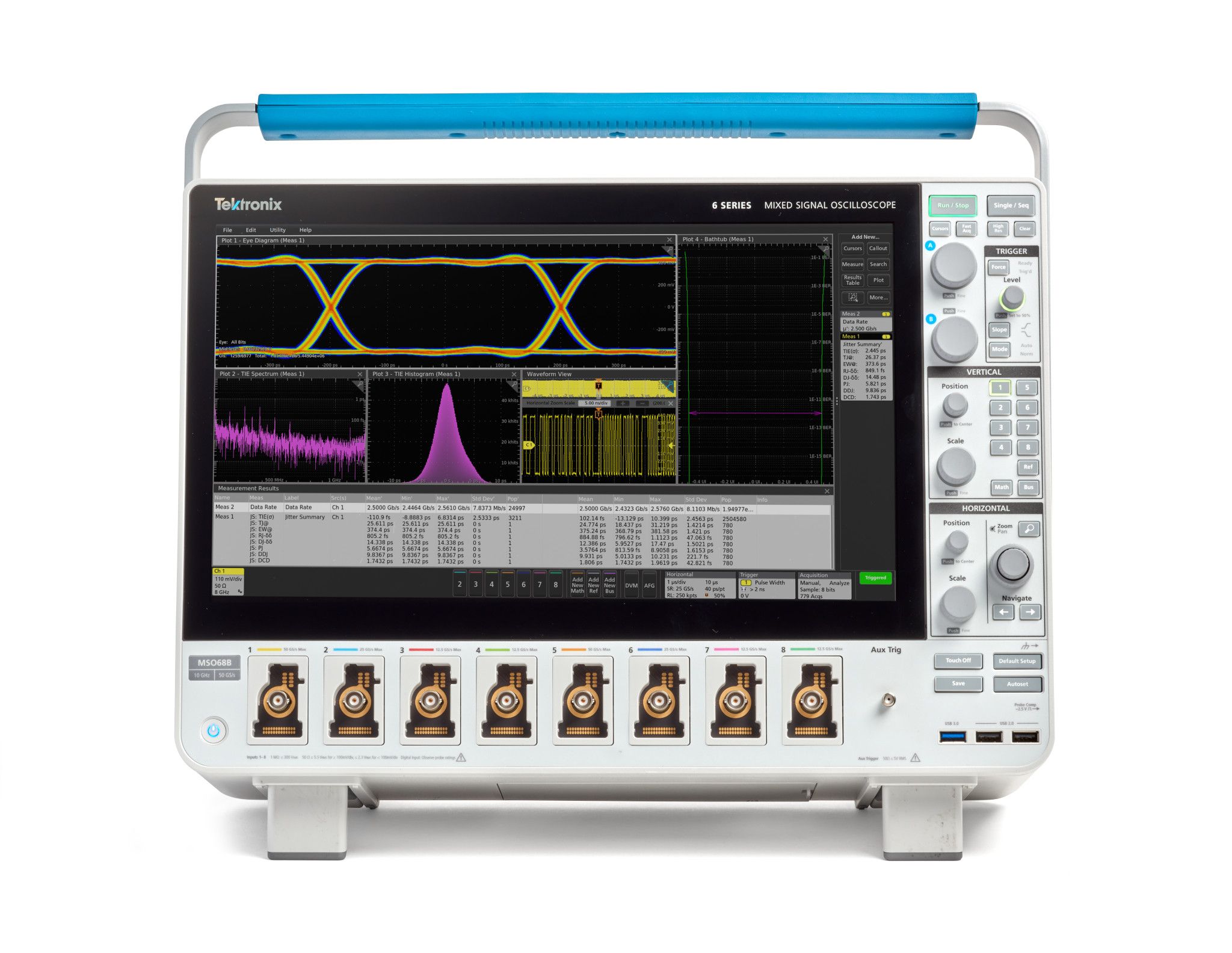スイッチング損失
バッテリー駆動デバイスの使用時間を延ばし、電力効率を向上させる需要が高まる中、電力損失を分析し、電源効率を最適化する能力が以前にも増して重要になっています。効率における鍵となる要素の一つは、スイッチング損失(スイッチング・デバイスでの電力損失)です。
このアプリケーションノートは、スイッチング損失の測定と、オシロスコープやプローブを使用してより良く、より再現性のある測定を行うためのいくつかのヒントを簡単に概説します。
典型的なスイッチングモード電源の効率は約87%であり、入力電力の13%が電源内で散逸しており、そのほとんどは廃熱としてです。この損失のうち、かなりの部分が通常MOSFETsやIGBTsなどのスイッチングデバイスで散逸しています。
理想的には、スイッチングデバイスは「オン」または「オフ」の状態であり、電灯のスイッチのようにこれらの状態間を瞬時に切り替えます。「オン」状態では、スイッチのインピーダンスはゼロであり、どれだけの電流が流れていてもスイッチで電力は散逸しません。「オフ」状態では、スイッチのインピーダンスは無限大であり、電流は流れていないため、電力は散逸しません。

実際には、「オン」(導通)状態でもいくらかの電力が消費され、しばしば、「オン」と「オフ」(遮断)の間、および「オフ」と「オン」(通電)の間の遷移時に、さらに多くの電力が消費されます。

これらの非理想的な振る舞いは、回路内の寄生要素によって発生します。図3のBに示されているように、ゲートに存在する寄生容量はデバイスのスイッチング速度を遅らせ、オンとオフの時間を長くします。MOSFETのドレインとソースの間の寄生抵抗は、ドレイン電流が流れているときに常に電力を消費します。

導通損失
導通状態では、スイッチには小さな抵抗とそれを通過する電圧降下があり、流れる電流の関数としてスイッチは電力を消散します。
MOSFETの場合、この電力は通常以下のようにモデル化されます:
P = ID2 * RDSon = ID * VDS
- IDはドレイン電流を表しています
- RDSonはドレインとソース間の動的オン抵抗で、しばしば1W未満です
- VDSはドレインとソース間の飽和電圧で、しばしば1V未満です
IGBTやBJTの場合、この電力は通常以下のようにモデル化されます:
P = IC * VCEsat
- IC はコレクタ電流を表しています
- VCEsat はコレクタとエミッタ間の飽和電圧を表し、しばしば1V未満です
ターンオン損失
通電時には、スイッチを通る電流が急速に増加し、デバイスを通る電圧降下がすばやく減少します。しかし、MOSFET内のゲートからドレインへの寄生容量などの寄生要素が、スイッチが即座にオンになるのを防ぎます。デバイスが通電している間、デバイスを流れる電流とデバイスにかかる電圧が大きく、大きな電力損失が発生します。
MOSFETの場合、通電時のこの電力は通常以下のようにモデル化されます:
P = ID * VDS
- ここで IDはドレイン電流を表しています
- VDSはドレインとソース間の電圧を表します
IGBTやBJTの場合、通電時にこの電力は通常以下のようにモデル化されます:
P = IC * VCE
- IC はコレクタ電流を表しています
- VCE はコレクタからエミッタへの電圧を表します
ターンオフ損失
通電時と似た方法で、遮断時にはスイッチを流れる電流が急速に減少し、デバイスを通る電圧降下が急速に増加しますが、回路の寄生要素がスイッチの瞬時の遮断を防ぎます。デバイスが遮断されている間、デバイスを流れる電流とデバイスにかかる電圧は大きく、大きな電力損失が発生します。上記の方程式も適用されます。
スイッチング損失の測定方法
スイッチング損失を測定する方法には2つのアプローチがあります。一つはマニュアルセットアップとオシロスコープの組み込み測定を使用する方法、もう一つはいくつかのオシロスコープで利用可能な自動測定システムを使用する方法です。自動測定には設定が簡単で、繰り返し結果を容易に得られるという利点があります。いずれの技術を使用する場合も、慎重なプロービングと最適化が良い結果を得るのに役立ちます。
プロービングと測定セットアップ
特定の電力測定について議論する前に、正確で再現性のある測定を行うための六つの重要なステップがあります。
1. 電圧オフセット誤差を取り除く:差動プローブ内のアンプにはわずかなDC電圧オフセットが存在する可能性があり、これが測定精度に影響を与えます。入力を短絡し、シグナルを適用せずに、プローブ内のDCオフセットを自動的または手動でゼロに調整します。
2. 電流オフセット誤差を取り除く:電流プローブには、プローブ内の残留磁気やアンプのオフセットによるDCオフセット誤差が生じることがあります。クランプを閉じてシグナルを適用せずに、プローブ内のDCオフセットを自動的または手動でゼロにします。
3. タイミング誤差を取り除く:瞬時電力測定は複数のシグナルに基づいて計算されるため、これらのシグナルが適切に時間同期されていることが重要です。電圧と電流を測定するために異なる技術が使用され、これらのデバイスを通る伝播遅延が大きく異なる可能性があり、これが測定誤差を引き起こすことがあります。良好な結果は、一般にデスキューメニューで名目上の伝播遅延の差を考慮してインターチャネルタイミングを調整することによって得られます。最も正確な結果を得るためには、すべての入力に高スルーレートのシグナルを適用し、すべてのチャネル間の相対的なタイミングオフセット(スキュー)を慎重に取り除きます。
4. 信号対雑音比の最適化:すべての測定システム、特に現代のオシロスコープのようなデジタルデバイスでは、ノイズの影響を最小限に抑え、垂直分解能を最大化するために、信号を可能な限り大きく(クリッピングしない範囲で)保つことが良好な測定技術として要求されます。これには、信号をプロービングする際に必要最低限の減衰を使用することや、オシロスコープの全ダイナミックレンジを使用することが含まれます。
5. シグナルコンディショニング:入力シグナルのコンディショニングによっても、測定品質を向上させられます。帯域幅制限を使用して、関心のある周波数より上のノイズを選択的に減少させられますし、平均化を使用して、シグナル上の相関がない、またはランダムなノイズを減少させることができます。ハイレゾリューション取得モードは帯域幅制限とノイズ削減を提供し、垂直分解能を向上させるとともに、シングルショットモードで取得したシグナルに対しても機能します。
6. 精度と安全性:最高の精度を確保するためには、機器を通常の運用範囲内で使用し、ピークレーティング以下で使用することが重要です。また、安全のためには、常に機器の絶対最大仕様内で操作を行い、使用に関するメーカーの指示に従ってください。
スイッチング損失の測定 - マニュアルセットアップと組み込み測定
遮断損失を測定する一つの方法は、ゲート付き測定を使用します。目的は遮断フェーズ中に散逸する平均電力を測定することです。例えば図4では、MOSFETのVDSを差動電圧プローブで取得し、黄色で示されています。ドレイン電流はAC/DC電流プローブで取得され、シアン色(明るい青色)で表示されます。各チャネルの垂直感度とオフセットは調整され、信号が垂直範囲の半分以上を占めるようになっていますが、目盛の上端と下端を超えないようにしています。

視覚分析において安定した表示が重要であるため、オシロスコープのエッジトリガーは電圧波形の50%点に設定されます。次に、信号のエッジの適切なタイミング分解能を確保するためにサンプルレートが設定されます。この場合、6.25 GS/sのサンプルレートを設定することで、スイッチング波形の各エッジに多くのサンプルポイントが得られます。最後に、ハイレゾリューション取得モードを有効にして、垂直分解能を16ビットに増加させます。
その後、波形数学を使用して電流と電圧を乗算し、オレンジ色の瞬時電力波形を作成します。自動測定を使用して、電力波形の代表値または平均値を測定します。
この例では、エンジニアは手動でオシロスコープを調整して、スイッチング損失測定の品質を最適化しました。後日、同じエンジニアまたは別のエンジニアが測定を少し異なる方法でセットアップする可能性は高く、その結果、測定結果が異なる可能性があります。そこで、電力分析ソフトウェアを通じて測定を自動化することで、多くの変動要因を排除できます。
スイッチング損失の測定 - 電力分析ソフトウェアを使用した自動測定
セットアップを一貫して最適化し、測定の再現性を向上させるために、電力測定アプリケーションが役立ちます。この場合、PWR Advanced Power Analysisアプリケーションはスイッチング損失測定のためのカスタムオートセットを提供し、ボタン一つでスイッチング損失の電力およびエネルギー測定の完全な一連の作業を実行します。
スルーレートとスイッチング損失
瞬時電力波形の検査から予想されるように、そして図5のスイッチング損失測定値によって示されているように、遮断損失は全体のスイッチング損失において支配的な損失メカニズムです。この大きな損失の潜在的な原因は、スイッチ駆動回路の性能にあります。駆動信号の遷移時間またはスルーレートが予想より遅い場合、スイッチは予想より長くオンとオフの状態の間に留まり、スイッチング損失は予想よりも大きくなります。

スルーレート測定は、与えられた時間間隔(通常はエッジ上の10%点と90%点の間)での電圧の変化を表し、単位はボルト/秒です。数学的な微分は本質的にハイパスフィルターであり、そのためノイズを強調する可能性があるため、これらの測定におけるランダムノイズの影響を減らすために平均化を使用することを推奨します。
スルーレート測定は、手動でカーソルを使用して行うことができ、一つの波形カーソルをシグナルエッジの10%点に、もう一つのカーソルを波形エッジの90%点に配置します。その後、カーソル間の時間差で電圧測定値の差を割ることによりスルーレートを計算します。この技術では、ユーザーが波形上の10%点と90%点を推定し、結果を計算する必要があります。

多くのオシロスコープは、自動測定を使用してこのプロセスを改善することができます。自動振幅と立ち上がり時間の測定を使用して信号の振幅を決定し、その振幅の10%と90%で測定閾値を設定し、信号の立ち上がり時間を測定することができます。さらに、複雑な信号の場合、カーソルゲーティングを使用して波形の特定の部分に焦点を当て測定することができます。その後、スルーレートは振幅を80%で乗算し、立ち上がり時間の測定値で割ることによって計算されます。
電力分析ソフトウェアを使用すると、スルーレート測定のセットアップが容易になり、回路内のコンポーネント値を設計エンジニアが調整する際の測定結果のばらつきを減少させられます。

図7のチャネル3で赤色に示されているMOSFETゲート(VGS)におけるカーソルゲートされたスルーレート測定では、スイッチングデバイスのゲートに予想以上の容量があったため、スイッチング信号が設計仕様よりもはるかに遅かったことを示しています。
図7で垂直カーソル間に示されている指数関数的減衰は、ゲート駆動回路の出力インピーダンス、スイッチングMOSFETデバイス内の寄生ゲート容量、およびゲートにおける回路基板の容量の影響によるものです。ゲート駆動の出力インピーダンスを減少させ、ゲートノードの容量を低減させることにより、駆動信号の速度を高めたところ、図8に示されるように、スイッチング損失がほぼ30%改善されました。

スイッチング損失測定は、スイッチモード電源の効率を最適化するための重要な部分です。良い測定技術を使用し、電力測定を自動化することで、複雑なスイッチング損失測定の一連を簡単に、迅速かつ繰り返し行うことが可能になります。
いくつかのTektronixオシロスコープシリーズでは、自動のスイッチング損失測定が可能です。特定の機器についての情報は、担当スタッフへお気軽にお問い合わせください。本アプリケーションノートで示されている測定は、以下の機器を使用して行われました。
スイッチング損失の測定に最適なオシロスコープ
スイッチング損失の測定に最適な最新オシロスコープをご紹介します。
4シリーズB MSOミックスド・シグナル・オシロスコープ
汎用性の高い4シリーズB MSOは、設計上の困難な課題に対応できる性能と、期待どおりに機能するユーザ・インタフェースを備えています。アップグレードされた新しいプロセッサ・システムを備えるこのオシロスコープでは、さまざまな解析ツールを使用して確度の高い測定を行うことができます。
5シリーズB MSOミックスド・シグナル・オシロスコープ
忠実度に優れた波形、多彩な測定表示、独自のスペクトラム解析、柔軟なプローブ技術により、設計の全体像を把握することができます。世界中のエンジニアに支持されている、直感的なユーザ・インタフェースをご体験ください。
6シリーズ B MSOミックスド・シグナル・オシロスコープ
1GHz~10GHzの帯域幅での高速設計のトラブルシューティング/検証。低ノイズ、最大50GS/sのサンプル・レートで正確な測定を実現。6チャンネル/8チャンネルの機種で設計のより詳細な解析が可能
スイッチング損失の関連資料
スイッチング損失に関する、閲覧数の多い人気資料をご紹介します。
- テクトロニクスAFG31000シリーズ任意波形/ファンクション・ジェネレータを使用したダブル・パルス・テスト
- PWMモータ・ドライブのパワー解析
- ターンオンおよびターンオフのタイミングとエネルギー損失の測定方法
- パワー半導体デバイスと効率性
製品についてご不明な点ございましたら、お気軽にお問い合わせください。
スイッチング損失に関するよくある質問
スイッチング損失とは?
スイッチング損失とは、電力変換器やスイッチング回路において、スイッチがオンからオフ、またはオフからオンに切り替わる際に発生する電力損失のことです。スイッチがオンまたはオフに完全に切り替わる瞬間に、電流と電圧が同時に存在し、それが発熱などの形で電力を損失します。この電力の損失がスイッチング損失です。
インバータのスイッチング損失の原因は?
インバータのスイッチング損失の原因は主に以下の3つです↓
- 遷移時間:スイッチがオンからオフ、またはオフからオンに切り替わるときに、電流と電圧が同時に存在するため、その間に電力が損失します。この切り替えの時間が長いほど損失が大きくなります。
- 寄生容量:インバータのスイッチには微小な容量があり、スイッチング時にこれが充放電されることで電力が失われます。
- 寄生インダクタンス:インバータ回路の配線やスイッチのインダクタンス成分が、スイッチング時に電力損失を引き起こします。
スイッチング損失を低減する方法は?
スイッチング損失を低減するには、スイッチの切り替えを速くし、電力損失を減らす必要があります。つまり、効率的な回路設計が必要です。インダクタンスやキャパシタンスの影響を最小限に抑えるように回路を設計することで、スイッチング損失を低減させることができます。
スイッチング損失の測定に最適なオシロスコープを活用すれば、効率的な回路設計が実現可能です。





